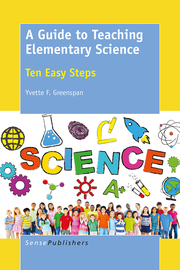Detailansicht
A Guide to Teaching Elementary Science
eBook - Ten Easy Steps
ISBN/EAN: 9789463003674
Umbreit-Nr.: 4138770
Sprache:
Englisch
Umfang: 0 S., 5.49 MB
Format in cm:
Einband:
Keine Angabe
Erschienen am 21.12.2015
Auflage: 1/2015
E-Book
Format: PDF
DRM: Digitales Wasserzeichen
- Zusatztext
- <div><p>Nationally and internationally,educators now understand the critical importance of STEM subjectsscience, technology,engineering, and mathematics. Today, the job of the classroom science teacherdemands finding effective ways to meet current curricula standards and preparestudents for a future in which a working knowledge of science and technologywill dominate. But standards and goals dont mean a thing unless we:</p><p> grab students attention;</p><p> capture and deepen childrensnatural curiosity;</p><p> create an exciting learningenvironment that engages the learner; and</p><p> make science come alive insideand outside the classroom setting.</p><p>A Guide to Teaching ElementaryScience: Ten Easy Steps gives teachers, at all stages of classroom experience,exactly what the title implies. Written by lifelong educator Yvette Greenspan,this book is designed for busy classroom teachers who face tough conditions,from overcrowded classrooms to shrinking budgets, and too often end up anxiousand overwhelmed by the challenges ahead and their desire for an excellentscience program.&nbsp;<p>This book:</p><p> helps teachers develop curriculacompatible with the Next Generation Science Standards and the Common CoreStandards;</p><p> provides easy-to-implement stepsfor setting up a science classroom, plus strategies for using all availableresources to assemble needed teaching materials;</p><p> offers detailed sample lessonplans in each STEM subject, adaptable to age and ability and designed toembrace the needs of all learners; and&nbsp;</p><p> presents bonus information aboutorganizing field trips and managing science fairs.</p><p>Without question, effective sciencecurricula can help students develop critical thinking skills and a lifelongpassion for science.</p><p>Yvette Greenspan received herdoctorate degree in science education and has developed science curriculum atall levels. A career spent in teaching elementary students in an urbancommunity, she now instructs college students, sharing her love for theteaching and learning of science. She considers it essential to encouragetodays students to be active learners and to concentrate on STEM topics thatwill help prepare them for the real world.&nbsp;&nbsp;</p></div>
- Kurztext
- Nationally and internationally,educators now understand the critical importance of STEM subjects-science, technology,engineering, and mathematics. Today, the job of the classroom science teacherdemands finding effective ways to meet current curricula standards and preparestudents for a future in which a working knowledge of science and technologywill dominate. But standards and goals don't mean a thing unless we: grab students' attention; capture and deepen children'snatural curiosity; create an exciting learningenvironment that engages the learner; and make science come alive insideand outside the classroom setting.A Guide to Teaching ElementaryScience: Ten Easy Steps gives teachers, at all stages of classroom experience,exactly what the title implies. Written by lifelong educator Yvette Greenspan,this book is designed for busy classroom teachers who face tough conditions,from overcrowded classrooms to shrinking budgets, and too often end up anxiousand overwhelmed by the challenges ahead and their desire for an excellentscience program.&nbsp; This book: helps teachers develop curriculacompatible with the Next Generation Science Standards and the Common CoreStandards; provides easy-to-implement stepsfor setting up a science classroom, plus strategies for using all availableresources to assemble needed teaching materials; offers detailed sample lessonplans in each STEM subject, adaptable to age and ability and designed toembrace the needs of all learners; and&nbsp; presents bonus information aboutorganizing field trips and managing science fairs.Without question, effective sciencecurricula can help students develop critical thinking skills and a lifelongpassion for science. Yvette Greenspan received herdoctorate degree in science education and has developed science curriculum atall levels. A career spent in teaching elementary students in an urbancommunity, she now instructs college students, sharing her love for theteaching and learning of science. She considers it essential to encouragetoday's students to be active learners and to concentrate on STEM topics thatwill help prepare them for the real world.&nbsp;&nbsp;
